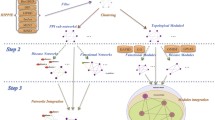Abstract
The human protein–protein interaction network (PIN) has a modular structure, in which interactions between proteins are much denser within the same module than between different modules. Proteins within the same module tend to have closely related functions with each other. Therefore, if a module is composed of relatively small number of proteins (e.g., modules composed of less than 5 % of all proteins in the PIN) and significantly enriched with target proteins for a disease, proteins and interactions in the module are likely to play an important role in disease mechanisms and may be potential candidate targets for the disease. We defined such modules as “drug-target modules.” In order to find drug-target modules in the human PIN, we developed a novel computational approach that decomposes the network into small modules and maps drug targets on the modules. The approach successfully identified drug-target modules that contain more than 40 % of targets of cancer molecular-targeted drugs (e.g., kinase inhibitors and monoclonal antibodies). Furthermore, proteins in the modules are significantly involved in cancer-related signaling pathways (e.g., vascular endothelial growth factor signaling pathway). These results indicate that the listing of proteins and interactions in the drug-target modules may help us to search efficiently for drug action mechanisms and novel candidate targets for cancerous diseases. It may be pertinent to note here that, among proteins in the drug-target modules, proteins with a small number of interactions may be potential candidate anti-cancer targets with less severe side effects.




Similar content being viewed by others
Explore related subjects
Discover the latest articles and news from researchers in related subjects, suggested using machine learning.REFERENCES
Barabási AL, Gulbahce N, Loscalzo J (2011) Network medicine: a network-based approach to human disease. Nat Rev Genet 12:56–68
Hase T, Niimura Y (2012) Protein– Protein interaction networks: structures, evolution, and application to drug design. In: Cai W (ed) Protein–Protein interactions—computational and experimental tools, InTech, pp 405-426
Jeong H et al (2001) Lethality and centrality in protein networks. Nature 411:41–42
Hase T et al (2008) Non-uniform survival rate of heterodimerization links in the evolution of the yeast protein–protein interaction network. PLoS One 3:e1667
Hase T, Niimura Y, Tanaka H (2010) Difference in gene duplicability may explain the difference in overall structure of protein–protein interaction networks among eukaryotes. BMC Evol Biol 10:358
Hase T et al (2009) Structure of protein interaction networks and their implications on drug design. PLoS Comput Biol 5:e1000550
Yao L, Rzhetsky A (2008) Quantitative systems-level determinants of human genestargeted by successful drugs. Genome Res 18:213–216
Wang Z, Zhang J (2007) In search of the biological significance of modular structures in protein networks. PLoS Comput Biol 3:e107
Guimerá R, Amaral LAN (2005) Functional cartography of complex metabolic networks. Nature 433:895–900
Ciriello G et al (2013) Emerging landscape of oncogenic signatures across human cancers. Nat Genet 45:1127–1133
Stark C et al (2006) Biogrid: a general repository for interaction datasets. Nucleic Acids Res 34:D535–D539
Prasad TSK et al (2009) Human Protein Reference Database - 2009 Update. Nucleic Acids Res 37:D767–D772
Knox C et al (2011) DrugBank 3.0: a comprehensive resource for ‘omics’ research on drugs. Nucleic Acids Res 39:D1035–D1041
Eran E (2009) GOrilla: a tool for discovery and visualization of enriched GO terms in ranked gene lists. BMC Bioinform 10:48
Acknowledgments
The authors thank Matsuoka Y, Kang H, Fujita K, Lopes T, Kikuchi M, and Shoemaker J for their useful comments and discussion. This study was supported by JSPS KAKENHI Grant Number 25870197 [Grant-in-Aid for Young Scientists (B)] to TH. For analyses in this study, we used the super-computing resource that was provided by Human Genome Center, the Institute of Medical Science, the University of Tokyo (http://sc.hgc.jp/shirokane.html).
Author information
Authors and Affiliations
Corresponding authors
Additional information
This work was presented in part at the 19th International Symposium on Artificial Life and Robotics, Beppu, Oita, January 22–24, 2014.
About this article
Cite this article
Hase, T., Kikuchi, K., Ghosh, S. et al. Identification of drug-target modules in the human protein–protein interaction network. Artif Life Robotics 19, 406–413 (2014). https://doi.org/10.1007/s10015-014-0178-5
Received:
Accepted:
Published:
Issue Date:
DOI: https://doi.org/10.1007/s10015-014-0178-5




